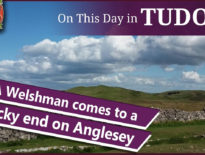Today, 26th July, is the feast day of St Anne, mother of the Virgin Mary and grandmother of Jesus Christ. Happy St Anne's Day to any Annes or Annas out there! Have a wonderful day!
St Anne was very important to Queen Anne Boleyn, second wife of King Henry VIII and mother of Queen Elizabeth I, and a pageant at her coronation procession in 1533 took St Anne, combined with Anne Boleyn's falcon badge, as its theme.
Find out more about the pageant at Anne Boleyn's coronation, and why St Anne was chosen as the theme, in today's talk.
You can read Nasim's article on Anne Boleyn's coronation procession at https://www.theanneboleynfiles.com/31-may-1533-anne-boleyns-coronation-procession/9995/
Also on this day in Tudor history, 26th July 1588, 4,000 men assembled at Tilbury Fort in an effort to prevent the Spanish Armada from travelling up the Thames and attacking London. Find out what had led up to this day in last year’s video:
Also on this day in history:
- 1538 – Death of George Talbot, 4th Earl of Shrewsbury and 4th Earl of Waterford, at South Wingfield Manor, Derbyshire. He was buried at St Peter's Church, Sheffield, in the Shrewsbury Chapel.
- 1614 – Death of Henry Grey, 1st Baron Grey of Groby, at Bradgate Park. He was buried in the family chapel.
Transcript:
Today, 26th July, is the feast day of St Anne, mother of the Virgin Mary and grandmother of Jesus Christ. Happy St Anne to any Annes or Annas out there!
We don’t know the birthdate of Queen Anne Boleyn, second wife of King Henry VIII and mother of Queen Elizabeth I, but I often wonder whether Anne was born on St Anne’s Day, although she may simply have been named after her aunt Anne who could have stood as her godmother. We just don’t know.
But St Anne was very important to Anne Boleyn.
At Anne Boleyn’s coronation procession on 31st May 1533, a tableau by John Leland and Nicholas Udall at Leadenhall in Gracechurch Street took St Anne as its theme. This two part pageant ot tableau featured Anne Boleyn’s falcon badge. A castle was depicted with a green, and a tree stump, and on a hill below the tree stump, sat St Anne and her descendants – her daughters, the Blessed Virgin, Mary Salome and Mary Cleopas; and their families. At this tableau, Anne was addressed by a boy speaking verses written by Nicholas Udall:
“For like as from this devout Saint Anne
Issued this holy generation,
First Christ, to redeem the soul of man;
Then James th’apostle, and th’evangelist John;
With these others, which in such fashion
By teaching and good life, our faith confirmed,
That from that time yet to, it hath not failed…”
As the boy finished speaking, out of the tree stump flowed red and white roses and then, out of a cloud painted on the roof of the tableau, swooped Anne Boleyn’s white falcon. The falcon landed on the stump and flowers and was then crowned by an angel with an imperial crown. It was Anne Boleyn’s falcon badge brought to life, explaining that Anne would revive the dead, barren Tudor line with children that came from both the York and Lancastrian lines.
This tableau and the poetry were emphasising England’s hope for Anne and the child she was carrying, that Anne, as historian Eric Ives explains, “would go on to rival the maternal success of her patron saint” and namesake. Of course, as Ives also points out, St Anne only produced daughters!
Nasim Tadghighi, in an article she wrote on the coronation procession for the Anne Boleyn Files, also explains “The name Anne was equated with ‘grace’ promoting the idea that through Anne’s marriage to the monarch and the bearing of issue, the realm would receive God’s favour, as St Anne was favoured by being the mother of the Holy Virgin.”
There were such high hopes for England’s new queen, but sadly she wouldn’t be given much of a chance to give Henry VIII children, being executed on false charges of treason less than three years after her coronation. She did, however, produce Queen Elizabeth I, a queen who is regarded as one of England’s greatest monarchs.



Leave a Reply